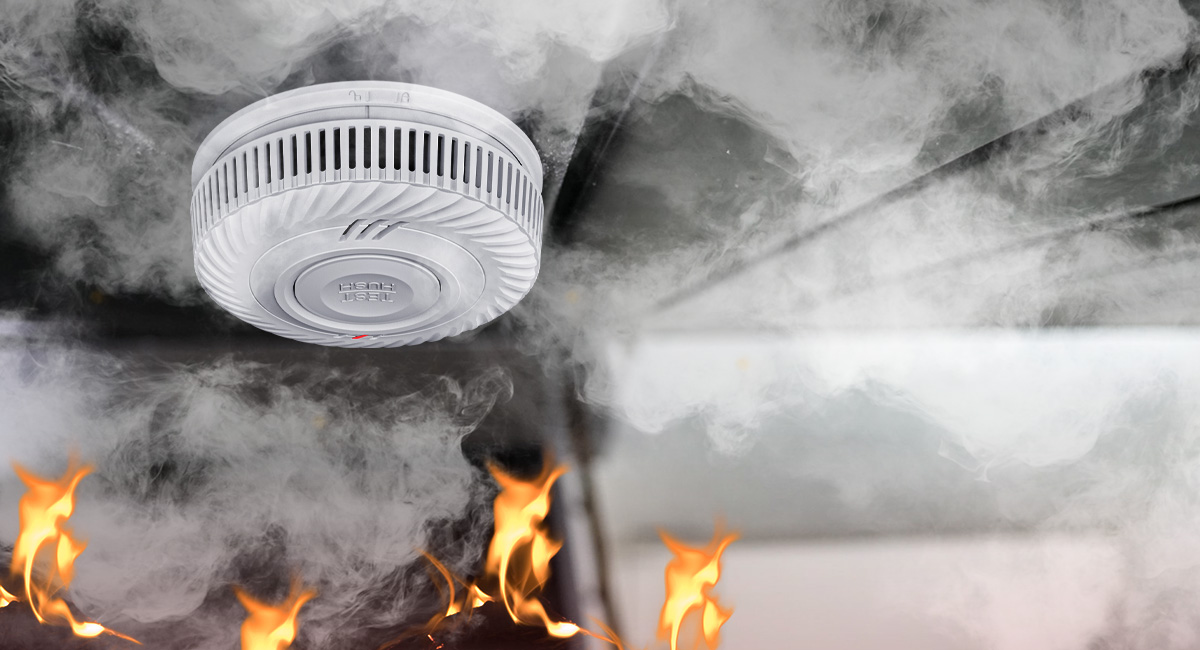በብሔራዊ የእሳት አደጋ መከላከያ ማህበር መሠረት ከአምስት የቤት ውስጥ የእሳት ቃጠሎ ሞት ሦስት ማለት ይቻላል ምንም የጭስ ማስጠንቀቂያ (40%) ወይም የማይሰራ የጭስ ማስጠንቀቂያ (17%) በሌለባቸው ቤቶች ውስጥ ይከሰታሉ።
ስህተቶች ይከሰታሉ፣ ነገር ግን የቤተሰብዎን እና የቤትዎን ደህንነት ለመጠበቅ የጭስ ማንቂያዎችዎ በትክክል መስራታቸውን ለማረጋገጥ ሊወስዷቸው የሚችሏቸው እርምጃዎች አሉ።
1. የውሸት ቀስቅሴዎች
የጭስ ማንቂያ ደውሎች አንዳንድ ጊዜ ነዋሪዎችን በውሸት ማንቂያዎች ሊያናድዱ ይችላሉ፣ይህም ሰዎች የሚያናድደው ድምጽ በእውነተኛ ስጋት ላይ የተመሰረተ መሆኑን እንዲጠይቁ ያደርጋቸዋል።
ኤክስፐርቶች የጭስ ማስጠንቀቂያዎችን በበር ወይም በቧንቧ አጠገብ እንዳይጭኑ ይመክራሉ. "ረቂቆች የውሸት ማንቂያዎችን ሊያስከትሉ ይችላሉ, ስለዚህ ጠቋሚዎችን ከመስኮቶች, በሮች እና የአየር ማናፈሻዎች ያርቁ, ምክንያቱም ትክክለኛውን ተግባር ሊያውኩ ይችላሉ.የጢስ ማውጫ” ይላል ኤድዋርድስ።
2. ወደ መታጠቢያ ቤት ወይም ኩሽና በጣም ቅርብ የሆነ ጭነት
ማንቂያ ከመታጠቢያ ቤት ወይም ከኩሽና አጠገብ ማስቀመጥ ሁሉንም መሬት ለመሸፈን ጥሩ ሀሳብ ቢመስልም, እንደገና ያስቡ. ማንቂያዎች እንደ ሻወር ወይም የልብስ ማጠቢያ ክፍሎች ካሉ አካባቢዎች ቢያንስ 10 ጫማ ርቀት ላይ መቀመጥ አለባቸው። በጊዜ ሂደት, እርጥበት ማንቂያውን ሊጎዳ እና በመጨረሻም ውጤታማ እንዳይሆን ያደርገዋል.
እንደ ምድጃ ወይም ምድጃ ላሉ ዕቃዎች፣ ማንቂያዎች የሚቃጠሉ ቅንጣቶችን ሊፈጥሩ ስለሚችሉ ቢያንስ 20 ጫማ ርቀት ላይ መጫን አለባቸው።
3. ስለ ምድር ቤት ወይም ስለ ሌሎች ክፍሎች መርሳት
የመሠረት ቤቶች ብዙውን ጊዜ ችላ ይባላሉ እና ማንቂያ ያስፈልጋቸዋል። በሜይ 2019 በተካሄደው ጥናት መሰረት፣ 37% ምላሽ ሰጪዎች በመኖሪያ ቤታቸው ውስጥ የጭስ ማስጠንቀቂያ እንደነበራቸው ተናግረዋል ። ነገር ግን፣ ቤቶቹም እንዲሁ የእሳት አደጋ የመጋለጥ እድላቸው ሰፊ ነው። በቤትዎ ውስጥ የትም ቢሆኑ የጭስ ማስጠንቀቂያዎ እንዲያስታውስዎት ቢፈልጉ። የቀረውን ቤት በተመለከተ፣ በእያንዳንዱ መኝታ ክፍል፣ ከእያንዳንዱ የመኝታ ክፍል ውጭ እና በእያንዳንዱ ደረጃ ላይ አንድ መኖሩ አስፈላጊ ነው። የማንቂያ መስፈርቶች በክፍለ ሃገር እና በክልል ይለያያሉ፣ ስለዚህ በአካባቢዎ ያሉትን ወቅታዊ መስፈርቶች በአካባቢዎ የሚገኘውን የእሳት አደጋ ክፍል ማነጋገር የተሻለ ነው።

4. የሌለውእርስ በርስ የሚገናኙ የጭስ ማንቂያዎች
እርስ በርስ የሚገናኙ የጭስ ማንቂያዎች እርስ በርስ ይገናኛሉ እና በቤትዎ ውስጥ የትም ቢሆኑም የእሳት አደጋን ሊያስጠነቅቅ የሚችል የተቀናጀ የመከላከያ ዘዴ ይመሰርታሉ። ለተሻለ ጥበቃ፣ በቤትዎ ውስጥ ያሉትን ሁሉንም የጭስ ማንቂያዎች ያገናኙ።
አንዱ ሲሰማ ሁሉም ይሰማሉ። ለምሳሌ, በመሬት ውስጥ ውስጥ ከሆኑ እና እሳቱ በሁለተኛው ፎቅ ላይ ቢነሳ, ማንቂያዎቹ በመሬት ውስጥ, በሁለተኛው ፎቅ እና በተቀረው ቤት ውስጥ ይጮኻሉ, ይህም ለማምለጥ ጊዜ ይሰጥዎታል.
5. ባትሪዎችን ለመጠገን ወይም ለመተካት መርሳት
ትክክለኛ አቀማመጥ እና መጫን ማንቂያዎችዎ በትክክል መስራታቸውን ለማረጋገጥ የመጀመሪያ ደረጃዎች ናቸው። ነገር ግን፣ እንደ ዳሰሳችን፣ ብዙ ሰዎች አንዴ ከተጫኑ ማንቂያዎቻቸውን እምብዛም አይጠብቁም።
ከ 60% በላይ ተጠቃሚዎች የጭስ ማንቂያዎቻቸውን በየወሩ አይፈትሹም. ሁሉም ማንቂያዎች በየጊዜው መሞከር አለባቸው እና ባትሪዎቹ በየ 6 ወሩ መተካት አለባቸው (ካለበባትሪ የሚሠራ የጢስ ማውጫ).
የፖስታ ሰአት፡ ሴፕቴምበር-12-2024




